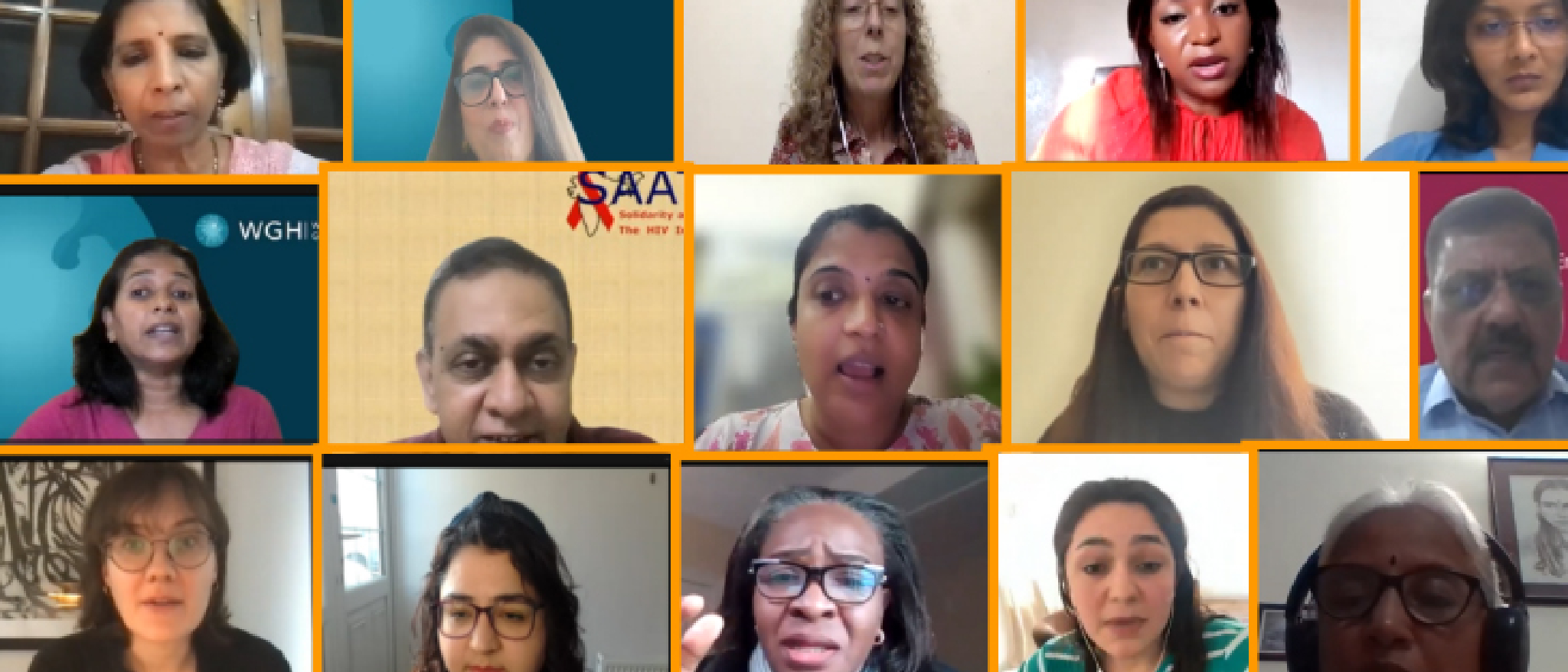Women in Global Health, Women in Global Health (WGH) – India, Alumni of Harvard Women Lead Fellowship and SAATHII co-organized a policy dialogue on 17th April 2023, titled, “Influencing the G20’s Commitment to Gender Equality in Health and Leadership”. The consultation’s goal was to gather actionable recommendations that can be implemented to achieve gender parity in health leadership and health, from representatives of civil society organisations across the Global South. Further, the four most important policy priorities are to be identified for submission to the G 20 working group on gender equality and disability, and G 20 leadership.
Speakers included public health experts engaged in diverse fields such as medicine, clinical psychology, epidemiology, social sciences, public health administration and advocacy, from India, Pakistan, Iraq, Nigeria, Somaliland, Malawi, Zambia, Argentina, and the United Kingdom. WGH chapter representatives highlighted priority areas for intervention in their respective countries to address challenges to gender equality in leadership. In addition, there were thematic commentaries on men’s involvement and disaggregated data, structures and policies for young career women and gender-based violence. Even though over 70% of the health workforce is made up of women, their representation in leadership is about 25%. Multiple layers of determinants impact women’s leadership in health, namely those operating at the individual, interpersonal, institutional, community and policy levels.
- Individual factors refer to, for instance, the lack of confidence and initiative among women to apply for leadership positions, poor awareness about gender gaps in leadership and their impact on both women health workers and patients.
- Interpersonal factors include sexual harassment and violence faced by women health workers from colleagues, communities and patients.
- Institutional factors comprise the inadequate support for women to stay in the workforce, in terms of maternity benefits, child care and flexible working hours, the lack of role models in managerial/senior positions, and the absence of the voices of cadres such as community health workers in decision-making.
- Community factors involve gender norms that restrict mobility and access to resources that would allow women to participate in the workforce, and perceptions about the unsuitability of women to be leaders.
- Policy factors refer to legal and policy frameworks that hinder women’s ability to participate fully in the workforce, including sexual harassment, equal remuneration, and parental leave laws.
Challenges pertaining to each of these areas were highlighted and cross-cutting recommendations provided to mitigate these, which have been summarized below.
1. Policy and law:
- 1.1. Laws against violence and sexual harassment at the workplace: Governments have a duty to ensure legal frameworks conducive for women and gender and sexual minorities to participate in paid work and hold perpetrators of violence accountable.
- 1.2. Ensure inclusion of gender experts in policy-making and planning: To ensure that policies address the unique health needs of different genders, including women, men, and non-binary individuals, reduce disparities in health outcomes between genders, gender experts must be a part of policy-making and planning bodies.
- 1.3. Greater focus on youth: More focus on SRHR among adolescents and youths is required as it is relatively neglected at the policy level, and on behaviour change communication and triggering change in social norms.
- 1.4. Recognize community health workers (CHW) as workers: CHWs work burden has been increasing as governments recognize the need for health promotion and for decentralizing various aspects of health care delivery; the COVID-19 pandemic brought this into sharp focus. Yet, they are the most undervalued cadre in health systems. Recognizing them as workers rather than volunteers with increased financing for CHW programs could be key to attaining universal health coverage.
- 1.5. Continued focus on sexual and reproductive health and rights: Invest in quality SRH information and services, education, skill building and gender equality initiatives. Scaling up and launching targeted social and behaviour change communication campaigns to address social norms, harmful practices, promote male engagement in family planning, all of which impact women’s healthand fertility outcomes.
2. Capacity building prior to entering the workforce:
- 2.1. Raise awareness of women’s leadership potential: Before women enter the workforce, it is important to ensure that they have access to education, and to educate them about their rights and autonomy. Leadership training could be included in school curricula. This must be complemented by building the capacity of men to be supportive and unbiased.
- 2.2. Address bias against non-heteronormative gender and sexual identities in curricula for health workers: Medical textbooks that pathologize non-binary gender identities need to be updated and providers must be trained on being gender-sensitive.
- 2.3. Greater synergy between academia and industry: Governments should be intentional in supporting women in public health institutions including schools of public health by designing policies that support professional development and grant writing skills among them.
3. Equitable organizational policies and capacity building of the workforce:
- 3.1. Quotas and targeted outreach to women during recruitment: Both countries and organizations can set quotas to ensure gender parity across levels including planning and policy-making. Outreach can also target women from under-represented groups such as ethnic, religious and gender or sexual minorities, and historically marginalized social groups.
- 3.2. Institute gender-sensitive policies for hiring: Conscious and unconscious bias in hiring practices can be reduced by employing strategies such as gender- blind applications, non-discriminatory interview questions (such those concerning marital status and future intentions to marry).
- 3.3. Policies supporting work-life balance and parental leave: Organizations must recognize that women bear disproportionate burdens in terms of unpaid care work. Laws and policies that enable flexible working, comprehensive childcare that is subsidized, parental leave and structured pathways to return to paid work after career breaks would enable more women in the health workforce to enter senior roles and prevent women from dropping out.
- 3.4. Mentorship programs for women: Mentoring women in the health sector can enable them to imbibe the knowledge, abilities, and motivation to aspire to and apply for leadership positions.
- 3.5. Support networks for women and men: Formal and informal peer support networks for women within the health system should be established and promoted. In addition, networks for men should be established to foster inclusive leadership skills, allyship, and gender-sensitivity, challenging the perception that men are “natural” leaders
- 3.6. Mental health support for health care workers: The mental health needs of health care workers owing to high workloads, inadequate resources, emotionally demanding work, lack of physical safety etc. need to be supported in the short-term during crises e.g., psychological first aid and in the long-term e.g., with self-care and mindfulness courses.
- 3.7. Development programs aimed at international recruits: Programs in HICs that support the professional development of health workers employed outside their native countries, often women from LMICs, would help familiarise them with the health system, and impart skills to aid career progression.
- 3.8. Train health care providers to identify and address gender-based violence: Service providers in the health system require intensive training on recognizing survivors of gender-based violence and providing non-judgemental, survivor-centred care, including the collection of forensic evidence.
4. Data and research:
- 4.1. Substantive engagement of men at all levels: Although men’s participation is acknowledged as being essential for gender equality, their engagement remains tokenistic. Research is required to comprehend (i) how health policies in different countries address male engagement (ii) how masculine norms are ingrained at all levels in the health system, and (iii) how to better address men’s health, sexual and reproductive health needs. These factors are all necessary to engage men in transformative roles.
- 4.2. Make disaggregated data available: Comprehensive gender- disaggregated data must be made available and analysed periodically to track gender inequities in health outcomes, inform policy and identify areas for gender- responsive action.
- 4.3. Monitoring and evaluation mechanisms: Program implementers are often tasked with M&E though they do have incentives to report on negatives. Formal mechanisms for M&E should be instated by allocating responsibility and resources to voluntary organizations that possess the capacity, but not the resources to undertake large-scale monitoring exercises.
- 4.4. Developing gender-sensitive indicators: Indicators used to assess health outcomes, governance and information and key inputs and processes need to be reviewed from a gender lens.
5. Ensuring Accountability
- 5.1. Develop accountability framework and mechanisms to ensure adherence to commitments: Strategies to ensure that commitments made during the G20 translate to action could include (i) advocating for a longer presidency to deliver on promises (ii) promoting watchdog organizations such as the WGH (iii) Policies should come with an action plan, that outline the what, how, where and when. Each policy should have clear budgetary commitments. There should be a reporting authority that is responsible and answerable for progress. The language of policy recommendations needs to be simple.




